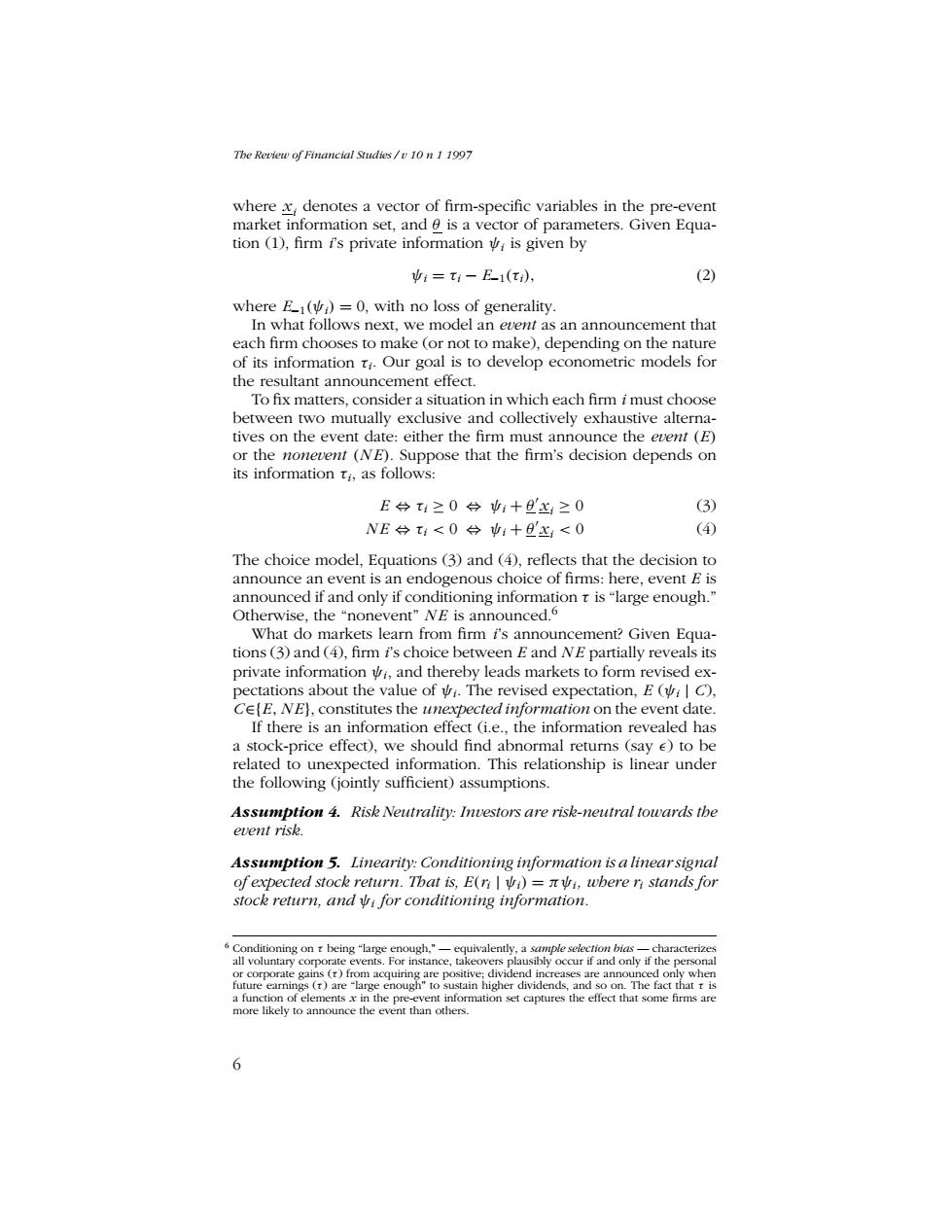正在加载图片...

Tbe Review of Financial Studies/v 10 n 1 1997 where x,denotes a vector of firm-specific variables in the pre-event market information set,and 6 is a vector of parameters.Given Equa- tion (1),firm i's private information is given by :=T1-E1(t), (2) where E()=0,with no loss of generality. In what follows next,we model an event as an announcement that each firm chooses to make (or not to make),depending on the nature of its information ti.Our goal is to develop econometric models for the resultant announcement effect. To fix matters,consider a situation in which each firm i must choose between two mutually exclusive and collectively exhaustive alterna- tives on the event date:either the firm must announce the event(E) or the nonevent (NE).Suppose that the firm's decision depends on its information t,as follows: E台t1≥0台:十且x;≥0 (3) NE台t1<0台:+旦x;<0 (4④ The choice model,Equations (3)and (4),reflects that the decision to announce an event is an endogenous choice of firms:here,event E is announced if and only if conditioning information t is "large enough." Otherwise,the "nonevent"NE is announced.6 What do markets learn from firm i's announcement?Given Equa- tions (3)and (4),firm i's choice between E and NE partially reveals its private information vi,and thereby leads markets to form revised ex- pectations about the value of i.The revised expectation,E(C), Ce[E,NE),constitutes the unexpected information on the event date. If there is an information effect (i.e.,the information revealed has a stock-price effect),we should find abnormal returns (say e)to be related to unexpected information.This relationship is linear under the following (jointly sufficient)assumptions. Assumption 4.Risk Neutrality:Investors are risk-neutral towards the event risk. Assumption 5.Linearity:Conditioning information is a linearsignal ofexpected stock return.That is,E(ri)=ni,wbere ri stands for stock return,and i for conditioning information. 6 Conditioning on t being"large enough,"-equivalently,a sample selection bias-characterizes all voluntary corporate events.For instance,takeovers plausibly occur if and only if the personal or corporate gains ()from acquiring are positive;dividend increases are announced only when future earnings (T)are "large enough"to sustain higher dividends,and so on.The fact that t is a function of elements x in the pre-event information set captures the effect that some firms are more likely to announce the event than others. 6The Review of Financial Studies / v 10 n 1 1997 where xi denotes a vector of firm-specific variables in the pre-event market information set, and θ is a vector of parameters. Given Equation (1), firm i’s private information ψi is given by ψi = τi − E−1(τi), (2) where E−1(ψi) = 0, with no loss of generality. In what follows next, we model an event as an announcement that each firm chooses to make (or not to make), depending on the nature of its information τi. Our goal is to develop econometric models for the resultant announcement effect. To fix matters, consider a situation in which each firm i must choose between two mutually exclusive and collectively exhaustive alternatives on the event date: either the firm must announce the event (E) or the nonevent (N E). Suppose that the firm’s decision depends on its information τi, as follows: E ⇔ τi ≥ 0 ⇔ ψi + θ0 xi ≥ 0 (3) N E ⇔ τi < 0 ⇔ ψi + θ0 xi < 0 (4) The choice model, Equations (3) and (4), reflects that the decision to announce an event is an endogenous choice of firms: here, event E is announced if and only if conditioning information τ is “large enough.” Otherwise, the “nonevent” N E is announced.6 What do markets learn from firm i’s announcement? Given Equations (3) and (4), firm i’s choice between E and N E partially reveals its private information ψi, and thereby leads markets to form revised expectations about the value of ψi. The revised expectation, E (ψi | C), C∈{E, N E}, constitutes the unexpected information on the event date. If there is an information effect (i.e., the information revealed has a stock-price effect), we should find abnormal returns (say ²) to be related to unexpected information. This relationship is linear under the following (jointly sufficient) assumptions. Assumption 4. Risk Neutrality: Investors are risk-neutral towards the event risk. Assumption 5. Linearity: Conditioning information is a linear signal of expected stock return. That is, E(ri | ψi) = πψi, where ri stands for stock return, and ψi for conditioning information. 6 Conditioning on τ being “large enough,” — equivalently, a sample selection bias — characterizes all voluntary corporate events. For instance, takeovers plausibly occur if and only if the personal or corporate gains (τ ) from acquiring are positive; dividend increases are announced only when future earnings (τ ) are “large enough” to sustain higher dividends, and so on. The fact that τ is a function of elements x in the pre-event information set captures the effect that some firms are more likely to announce the event than others. 6